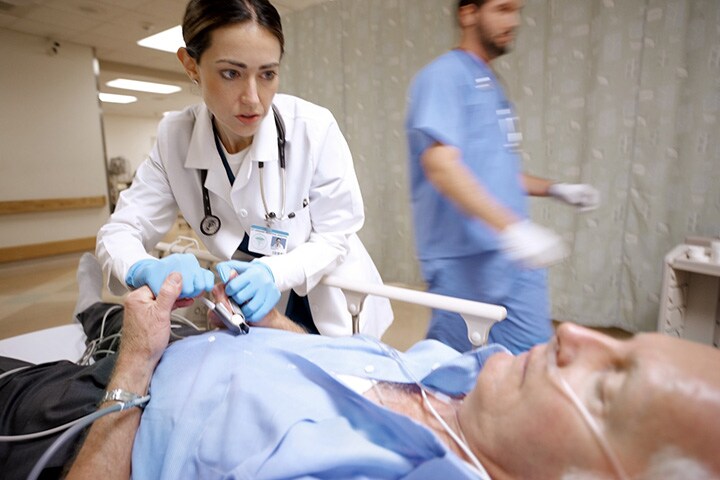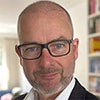On average, an acute stroke occurs roughly once every 5 seconds, globally amounting to around 6.5 million cases a year [1]. If left untreated, every single one is a personal and societal tragedy, either through loss of life, or severely impaired quality of life. Stroke remains the world’s leading cause of disability and a leading cause of death due.
However, if patients receive the right treatment at the right time – as quickly as possible after symptom onset – most of a stroke’s debilitating effects can be avoided. Some patients have even been able to return to normal life as soon as the following day. Today, however, only around 5% of stroke patients receive endovascular thrombectomy treatment that can avoid the worst effects of major ischemic strokes. In some parts of the world, the percentage is close to zero.
Addressing this reality was one of the major discussion points at the 2023 World Stroke Congress in Toronto, Canada (WSC 2023, October 10 – 12). In the following interview, Angelique Balguid, Portfolio Marketing Leader for Neurovascular at Philips, looks back at WSC 2023 and the steps that have been made.
What were the main highlights for Philips at WSC 2023?
One of the main highlights was the roundtable discussion with global pioneers of endovascular thrombectomy and executive leaders of the World Stroke Organization (WSO) on the eve of the congress. The objective was to arrive at a consensus about how we can drive access to game-changing endovascular therapies and generate awareness among policymakers and governments of the need for greater focus on stroke.
The discussion highlighted both the growing clinical evidence on the patient-outcome benefits of endovascular treatment, as well as issues such as health economics, reimbursement, which stakeholders need to be engaged, which organizations we should team up with, and what needs to be created in the form of policy documents. To deliver brain-conserving treatment within hours of symptom onset, you need a complete end-to-end infrastructure from first-responder ambulance services and emergency department triaging to timely angio suite treatment and post-procedure monitoring. Even in the world’s developed countries, access to that infrastructure can still be a lotter’. In mid- and low-income countries, it is often non-existent.
What was your most significant take-home message from WSC 2023?
Since key trials came out in 2015, showing that endovascular therapy was superior to the existing standard of care, clinical evidence that an increasing number of patients could benefit from endovascular treatment has kept evolving. So we see that stroke is now successfully treatable for a much larger group of patients than was previously thought possible. Yet we still have a long way to go in bringing the life- and quality-of-life-saving benefits of the latest endovascular therapies to patients worldwide.
When mechanical thrombectomy for LVO stroke was first introduced, it was only recommended for patients with a relatively small amount of damaged brain tissue who could be treated within six hours of symptom onset. A few years later, the treatment window became 24 hours. Then during last year’s WSC, late-breaking data from the MR-CLEAN study was presented [2] that showed even for patients with large strokes, where an extensive part of the brain is impacted, it is still worth performing mechanical thrombectomy. And with this evidence evolving, there is a noticeable shift from a mindset of ‘only treat if’ to one of ‘treat unless’ – something that will undoubtedly affect future guidelines.

And the biggest challenge?
The challenge now is to create much greater awareness among governments and policymakers of the need to invest in better stroke care, and implement the infrastructures needed to ensure all those patients who could benefit from endovascular procedures such as mechanical thrombectomy are able to receive them. And that’s something Philips cannot do alone. It’s why we’re partnering with the World Stroke Organization (WSO) to leverage our combined strengths in getting the message across. We’re also collaborating with the WSO to educate people to recognize the signs of a stroke and to react accordingly. And that starts with World Stroke Day on October 29, 2023. With 6.5 million new stroke cases every year, we owe it to patients, their families, and loved ones.
Philips also hosted a symposium titled ‘Challenging the Status Quo of Stroke Care’ on the first day of the congress. What did that cover?
Our symposium covered some of the latest innovations as well as future developments that could help healthcare providers put effective stroke care infrastructures in place and improve patient management.
Dr. Marc Ribo, interventional neurologist at University Hospital Vall d'Hebron (Barcelona, Spain) gave a presentation on an artificial intelligence (AI) powered smartphone app, currently being developed by healthtech start-up CVAid, that analyses face and arm movement characteristics, together with question-and-answer results, to triage patients in ambulances and emergency departments and identify those with large vessel occlusion (LVO) stroke. Those patients could then be quickly routed to the nearest stroke care center where they can get the right treatment. Today, a large number of stroke patients are routed to the wrong hospital, where they don’t have access to the right treatment. This causes huge delays, with the result that millions of brain cells die unnecessarily.
Nicole Cancelliere, Research Program Manager and Neurointerventional Technologist at Unity Health Toronto (Toronto, Canada), spoke about innovations in 3D neuroimaging currently in development at Philips that will provide the diagnostic confidence needed to facilitate a time-saving ‘Direct-to-Angio-Suite’ pathway for the faster treatment of LVO stroke. We know from the literature that a significant amount of time is spent performing diagnostic imaging to confirm a treatable stroke. By offering advanced imaging in the angio-suite, diagnosis and treatment can be done in the same room, saving precious time for eligible stroke patients.
Professor Wim van Zwam, Neurointerventional Radiologist at the Maastricht University Medical Center (Maastricht, the Netherlands) discussed ‘Reperfusion therapy for wake-up stroke patients: forget about 'last known well'!’. Today, the ‘last known well’ time dictates the protocol that is followed in the hospital. So-called ‘late window patients’ will get extra imaging and tests, causing additional delays. Prof. van Zwam proposed that wake-up stroke patients – those whose stroke symptoms are only noticed when they wake from sleep – who currently account for around 20% of stroke cases, should be treated in the same way as patients with an early symptom onset time. Based on his experience of treating hundreds of stroke patients every year, he believes that a large number of these patients wake up as a result of stroke. He therefore argues that wake-up stroke cases are really early onset cases and should be treated according to the guidelines for early time-window patients.
The last speaker was Manish Wadhwa, MD, Chief Medical Officer of Philips’ Ambulatory, Monitoring and Diagnostics Business and a practicing cardiologist/electrophysiologist, who spoke about the importance of post-operatively monitoring stroke patients for atrial fibrillation (AF). It is well known that AF is a common cause of ischemic stroke and a risk factor for subsequent strokes. He suggested, however, that the frequency and duration of AF that constitutes a risk factor for stroke is still open to question, and that continuous monitoring and analysis of data over days and weeks, such as can be obtained using Philips’ ePatch, will be important to develop algorithms that can detect stroke-significant AF in patients.
What areas of innovation are most important for Philips?
As a leading healthcare technology company committed to connecting the dots between and streamlining every stage in the patient pathway, our innovation focus is clearly on ensuring that stroke patients are treated as quickly and efficiently as possible to preserve their quality of life. We will continue to innovate in areas such as first-responder and ambulance care, tele-stroke services to ensure faster diagnosis, rapid emergency department triaging, advanced diagnostic imaging, real-time image-guidance and procedure optimization in the angio-suite, and post-procedure patient monitoring for AF. [1] https://www.cdc.gov/stroke/facts.htm
[2] https://www.vjneurology.com/mr-clean-late-results-presented-at-the-world-stroke-congress-2022/
Share on social media
Topics
Contact

Joost Maltha
Philips Global Press Office Tel: +31 6 10 55 8116
You are about to visit a Philips global content page
Continue












